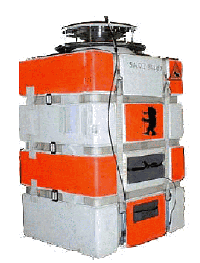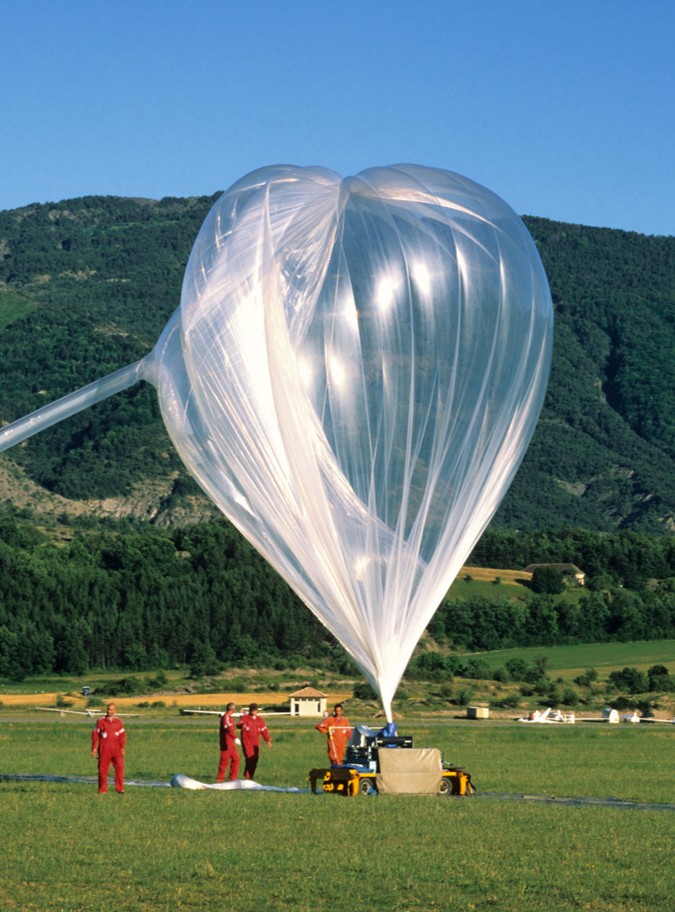Purpose of the flight and payload description
It is a UV-visible spectrometer able to provide vertical profiles of O3, NO2, OClO, BrO and H2O by solar occultation during ascent of the balloon (or descent) and from float at 30 km during sunset (or sunrise). The balloon version of the SAOZ instrument is very similar to the one used for ground-based measurements of total ozone and NO2.
It is composed by a commercial flat field, 360mm, holographic grating spectrometer equipped with a 1024-diode linear array and an entrance slit of 50 µm. A simple conical mirror replaces the gondola orientation or sun tracker systems generally used on large balloon platforms and is driven by an on-board computer, connected to a PTU (Pressure, Temperature and Humidity) sensor, a GPS (Global Positioning system ) for the localisation (Altitude, latitude and longitude) and an Argos transmitter for the recovery of the payload after cut-down and descent under parachute.
At left can be seen a picture of the standard package (click to enlarge).The weight of the instrument is 20 Kg and is contained in a insulated box with only a small aperture in the top for capture the solar rays. It's currently flown in three configurations, SaOZ-Standard, SAOZ-BrO and SAOZ-H2O each tuned to a different wavelength for measurements of different atmospheric constituents.
As a piggyback was an amateur experiment called PAPARAZZI 2 aimed to take, with regular intervals, a series of numerical photographs of the ground flown over by the balloon. The experiment also takes measurements of the parameters defining its environment, such as the outside and inside temperature and the atmospheric pressure, and finally an antenna GPS, which allows its localization by satellite.
Details of the balloon flight
Balloon launched on: 6/21/2001 at 17:45
Launch site: Aérodrome de Gap-Tallard, Haute Alpes, France
Balloon launched by: Centre National d'Etudes Spatiales (CNES)
Balloon manufacturer/size/composition: Zero Pressure Balloon model 10zl Zodiac - 10.000 m3
Balloon serial number: 10ZL Nº 95
End of flight (L for landing time, W for last contact, otherwise termination time): 6/21/2001 at ~ 22:00
Balloon flight duration (F: time at float only, otherwise total flight time in d:days / h:hours or m:minutes - ): 2h 19 m
Payload weight: 110 kgs
Gondola weight: 62 kgs
The launch operations began at 19:25 local time when started the balloon inflation.
At 19:45 the balloon was released. After takeoff, the balloon rised with a climbing speed of 7 m/s approximately during 1 hour and 20 minutes to reach the float altitude of 29.5 kms and remained almost motionless and visible with the naked eye until sunset.
At 22:00 the operations center of CNES cutdown the payload wich land 30 minutes later.
The next day, the recovery team using a helicopter, located the balloon envelope and the payload and return it to Gap-Tallard.
(extracted from GAREFF field diary -see link bellow-)
External references
- SAOZ balloon program Service d'Aéronomie, Centre National de la Recherche Scientifique
- GAREF science club web site
- SAOZ balloon profiles for the validation of OSIRIS, SCIAMACHY and GOMOS at various latitudes 17th ESA Symposium on European Rocket and Balloon Programmes and Related Research, 30 May - 2 June 2005, Sandefjord, Norway
765If you consider this website interesting or useful, you can help me to keep it up and running with a small donation to cover the operational costs. Just the equivalent of the price of a cup of coffee helps a lot.



